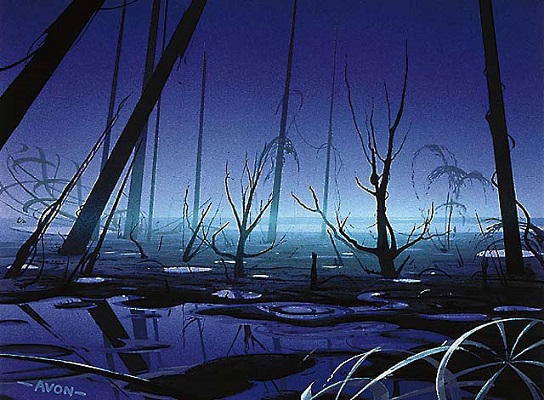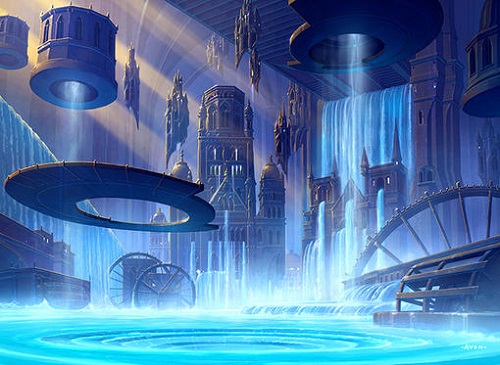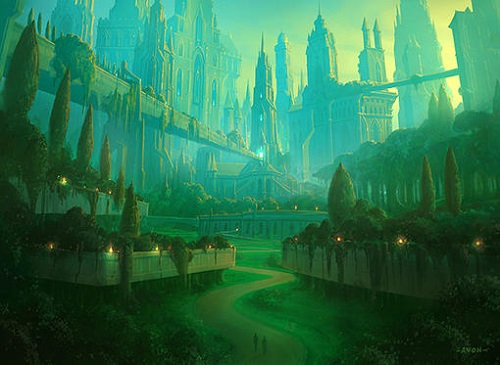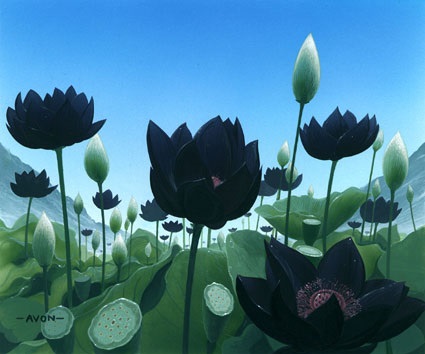Among Magic players and collectors, John Avon has become well known for his beautiful landscapes and his incredibly detailed and inventive style. With over 200 images to his credit, John has been deeply involved in shaping how we all experience the game of Magic: The Gathering.
In an effort to learn more about his process and his recent transition to entirely digital production, I reached out to his business agent, Guy Coulson, and was able to secure an interview.

John, you’ve become known for your illustrations of landscapes. When creating a new piece, do you use existing natural landscapes as a reference?
Yes, I either look at my own photographs, of which I have thousands, or I Google the particular direction I’ve been asked to paint from the style guide to get ideas. Then I get a file together with up to 30 images, which I like to lay out in front of me on my desk to draw from. I always use reference to assist me for my ideas. Sometimes I just sit down and do a thumbnail sketch to get a design going.
If I use thumbnail sketches, often they are better because I concentrate on the design as opposed to the subject matter.
Are there any parts of the world that you tend to use more often as a reference?
I used to use a lot of pine forest references from North America. I’ve often used jungle environments because of the vines and tropical fauna. I’ve frequently used parts of Europe and Germany. I use whatever I stumble across; I tend to enjoy the unpredictable nature of things.
Many years ago, I used to rely upon a huge collection of books. It would just be quite spontaneous as to what I would pick up and thumb through, and I quite like the way that works. Often I will just look at my reference from one of the more recent countries I’ve visited.
Do you prefer to do landscapes over single figure pieces? If so, what appeals to you most about creating landscapes for Magic?
I enjoy doing landscapes because I can disappear into the landscape. That sounds like a complete cliche, but it’s true. If you’re sitting there for upwards of two weeks with an image—let’s say you are looking at a monster or an ugly creature or a single face—you have a relationship with that image. So if you’re say painting a monster which is six foot away from the viewer, you tend to have that image in your mind every day. If you’re painting a beautiful landscape or beautiful cityscape, first of all the image is further away from you, so you’ve got some distance from it. Also, you can lose yourself in the environment, so generally it is more therapeutic painting landscapes.
So you almost meditate within the image while you are painting it?
Yes, you can get lost. One of the things I like doing, particularly when I am away, is sitting on a balcony looking over a city or, if I’m lucky, sitting on a balcony overlooking a beautiful mountain range. You can dream and disappear and dissolve from all your thinking.
Having worked on art for Magic since Mirage, you’ve seen firsthand the changes in the game over time. How has the recent cohesive approach to world building affected your work? Has more active art direction been helpful or a hindrance to your creativity?
First of all, I completely understand that the art direction has gotten more and more specific. They have to do that because there’s only a certain amount of ways you can paint an island or a forest or a monster or a figure. So it’s completely inevitable that things had to change from the old days where I’d be asked to just paint a mountain or just paint a forest and simply had to make sure it had a blue palatte or a green palatte.
So, for instance, with your Unhinged lands were you given any art direction?
None whatsoever. I was just told to paint a forest.
It’s very interesting that they are some of the most popular images in the game, don’t you think?
It is interesting. I’m most known for my Unhinged lands, of which I’m very pleased that people like, but I enjoy some of the more complex, specific things. That might just be because my work has become more sophisticated.
Right now, I think I enjoy someone saying create an island with a certain feel to it since it immediately gives me a direction and a flavor because again for myself there is only a certain amount of ways you can paint an island. Take the Zendikar Swamp, for example, which we had to paint vertical instead of horizontal. If you think painting a vertical swamp is quite a challenge, it’s liberating because it forces you to do something in a way you wouldn’t normally do it. Though that’s challenging, it’s actually easier because it means you can do something that hasn’t been done before.
People always ask this, and it makes me smile because it’s the hardest one, which was Ravnica. I love buildings and science fiction, and there’s a slight sci-fi element to Ravnica. If I had my way I would love Magic to do a specific science fiction set with loads of buildings, but I know that is never going to happen. Magic is by necessity fantasy, so I love Ravnica because it’s got that slight sci-fi look and when I was young I was potentially going to be an architect.

What was your favorite set or block to do art for?
The only downside of Ravnica was that because I paint and draw everything out in mostly correct perspective, it takes me at least three to four times longer to produce a piece. It is a complete pain in the butt, but that’s the way I work. I can’t paint a load of windows on the side of a building wrong because I know how they are supposed to look. Other artists who haven’t trained in perspective can quite easily do everything slightly wrong and make it look great. Their style means they can paint things slightly out of line because that’s their look. It works, but I can’t do that—I have to paint things correctly because I know how to construct buildings.
Recently, you let your fans know that you are going 100% digital in the future because you started doing your sketches digitally. How is this transition going for you, and has there been any reaction from your fans?
I don’t know of any reaction from fans, but I know that it’s because I’ve got the very latest Wacom digital drawing tablet and a much larger monitor along with the new version of Photoshop, which enabled me to create my line in a more organic way. Unlike a lot of other digital artists, I’ve never been able to use Painter—not because I don’t think it’s great but because I’ve not felt comfortable using the program. So I use Photoshop because it’s what I know, and the latest version has become a little more like what I know Painter would be. For example, the “pencil” brush in Photoshop has become so organic and pressure/tilt sensitive that I have been able to create a line which is literally like my pencil line. Because I haven’t been well for while, anything that makes the process quicker and easier is a benefit.
So, yes, I haven’t got my drawings at the moment, but I might go back to it. The way I am working in Photoshop means I can have an outline behind as a guide from some of my bits of reference and then can create a layer and draw the drawing on top. Currently, it’s working very well; it probably saves about eight hours of my time, which is a huge amount of time in terms of trying to make a living out of being a painter. On one level it’s a bit sad because there aren’t any more drawings, but at the moment it’s working. I can use the digital drawing and send it straight off to the clients. I don’t have to scan it in. That is how I am doing things at the moment, but things always change because, paradoxically, I’ve recently started doing oil painting, which means I have to draw things out in charcoal pencil.
So here I am, doing Magic cards, finally drawing them digitally, and now I’m going back to do my oil paintings again as well. Further down the line, I might even do a Magic card in oils. Everything is in a state of change, as it should be in life.
Your trajectory, moving from physical to digital media, is being mirrored by many other artists, and much of the new Magic art is now produced digitally. Do you think that full digitization is inevitable in the commercial illustration industry? What role do you see for physical media in the future?
It’s inevitable at the moment.
When I started using computers, they could hardly handle the gestures I would make on a high-res file. There was no way I could do a Magic card digitally because the processor would not have been able to handle me doing a quick gesture across the screen. It would be like a little snail following across the monitor. There is no way I could have done that.
Since I trained classically to paint, what I do digitally is just an extension of what I would have done with a paintbrush. Now that I’m going back to using a paintbrush, it’s no different other than the fact that there is no undo button. So on that front it’s rather strange because sometimes when I am painting with oils I literally think I must save the image, which is ridiculous because it’s done with paint.
Getting back to your question, it’s completely inevitable that artists will take the shortest and quickest route to get a result. I’m not a purist. I think it’s ridiculous to have some grand idea about how things should and shouldn’t be. Progress has enabled these wonderful futuristic tools for artists to make their marks with. I can actually see whether an artist has never painted by hand because I can tell their marks have grown. If you think about it, it’s literally marks. Every gesture is a mark, and I can see whether an artist has painted by hand ever. It’s not for me to say whether it’s good or bad, but I can see it.
I think things will take their natural course. There will always be a reaction to anything. When I was going into recording studios with my band, there were analog mixing desks. Then, in the ’80s and ’90s, there were digital mixing desks. Now, they are going back to using analog, and the pedals I used to use in the ’70s, which were all analog stomp boxes, are the ones that everyone wants today. It’s a cycle, so nothing is wrong—it’s all right. It’s just the way things go: the evolution, the destruction, then going back and doing a bit of both and seeing what happens.

You’ve teamed up with StarCityGames.com to offer a series of large lithographic prints. How has the fan reaction to this been so far?
My first answer is I haven’t a clue.
My second answer is that it must have gone well because they’ve sold a lot of prints.
It makes me feel good that there are now thousands of large-scale prints on people’s walls. It’s a real privilege that someone would want to have an image of mine that big in their room. Certainly when I was a student (I’m not saying everyone who buys them is a student), people would generally put posters on their wall or frame them if they had a certain amount of money. I know that when I was in my 20s or my teens, having a poster on the wall was a very important thing because I would disappear and dissolve into that space. It’s a wonderful privilege to have that happen, and it’s all thanks to Guy, who made it happen.
When you attend Magic events, what card do you sign the most of?
I’ve signed hundreds of Unhinged lands and lots of the full art Zendikar lands. In the old days, I used to sign stuff that I don’t see anymore. It tends to be just what’s out at that moment or has been out over the last few years. Obviously, loads of lands.
What is the oddest request for an alter you have received?
It always makes me smile. When I was at Paris Worlds, this bloke asked me to draw a swimming pool from above but very small. I’m trying to think of what image that would have been; it must have been an aerial view of something. I drew a tiny little rectangle with a line around it, saying that was a swimming pool from above. He wanted it to be very small, so he was very happy with that. I was very happy to do it because it didn’t take me more than a second.
At my first ever signing, in Essen, there was a man who wanted me to draw a very muscular version of him on top of one of my Mirage Mountains. I tried to point out to him he’d be a dot unless he was a giant. He said, “Yes, can you draw me as a giant on top of the mountain?” I said, “You’re still going to be pretty damn small unless you’re as big as a mountain.” I did this little stick man with loads of muscles, and he was extremely happy with it. Of course, I had to try to not laugh because to him it was incredibly important, but it was bloody funny.
In your biography on Johnavon.com, you list through some of the destinations that Magic has taken you. What would you say has been your favorite location?
Looking back, it has to be my signing in Zurich. The guy who brought us over, who I haven’t heard from in years, got a prize from his company to have a holiday with Anthony Waters and me to take us on a tour around Switzerland and the Swiss Alps. I can quite honestly say that was the most enjoyable signing because the Swiss Alps must be the most beautiful place I have ever seen. It’s not the most unusual place I’ve seen—that would probably be Russia, Japan, or parts of Cape Town—but the Alps are one of the most wonderful places I’ve been to. I want to go back as soon as possible.
Have any of the Magic event locations been an inspiration for your work?
Oh yes, definitely. I use them in my reference shots. I use reference in a very oblique way in that I very rarely will specifically paint something exactly as it is. The whole nature of fantasy is that you can be surrealistic and take one element, say from a swamp, and put it along somewhere where it would never be. As an overall answer to the question, yes and no.
What is your best memory of doing art for Magic?
Drawing out my first ever Mirrodin Forest because I really clicked into the shapes. I remember emailing the art director, Jeremy Cranfield at the time, and telling him in big bold letters that “I LOVE MY JOB!” I remember going to Pro Tour London, which I didn’t attend as an artist, just to meet him, and he was giving a talk about Magic art. He remembered that being something that affected him because obviously it’s nice for them to hear back from artists that they love their job. Occasionally, I become aware of what I’m doing and that I’m enjoying what’s coming out. Half the time I’m working in a state of fear as to whether I can do it.
In this particular case, I became aware that the marks I was making were giving me a thrill. The universe was working through me, and in a way I was just a conduit for something to happen. That might sound corny, but it’s true. When an artist gets into the zone, things work through you as opposed to just what you’re thinking.

Is there a piece or person that you met through the game that you will never forget?
There is a type of person that I’ve met at many events which is invariably a happy couple who both play Magic and are both massive fans of the artwork. I can see them in my mind’s eye. They’re a sort of loving, happy twosome who live for Magic and have queued up for hours and are very appreciative of what I’ve done and what the other artist next to me has done. They just seem genuinely happy to meet me. I always think that’s incredible because I’m just a bloke. Then I realize what I’ve done is more than just the art—I’ve created something that has connected with them.
So these people, who go home with some prints, some drawings, and some signed cards, just make me feel incredibly happy because I’m a horrible critic of myself. When I meet these fans, individuals or larger groups, they just make me feel like there is some validity to what I do. As Guy will know, having worked with me now for a couple of years, I often find what I do incredibly difficult, and because I have a health condition, half the time I am working in a state of pain. Frequently what I’m doing is physically very difficult, so if I travel and meet people who seem to be happy-fied by what I do, then I go back to the hotel or come home thinking there is some point other than just making a living and painting pictures. It’s all about connection, and as everyone knows in their work, it’s not just about making a living; it’s about connecting with people. Art just enables you to do that in a very profound way.
Do you know if you will be attending any Magic events this year, John?
Probably not. If someone can FedEx me a new body…
I’m 6’2.5″ I’m 52 years old with brown hair, an average build, and am not overweight. So if you could maybe on eBay find a new John Avon body, send it to me, and I’ll stick my head on it and come sign Magic cards and meet people. At the moment, I’m physically not in a good state, but mentally I’m as fresh as anything—just need a new body.
Thank you John for your great contributions to the game, and I can’t wait to see what you have coming out in the future.
If you are a fan of John’s work, let me know your favorite piece in the comments.
You can check out full size images of John’s work on his website, and make sure to check out StarCityGames.com series of John Avon Lithographs.
